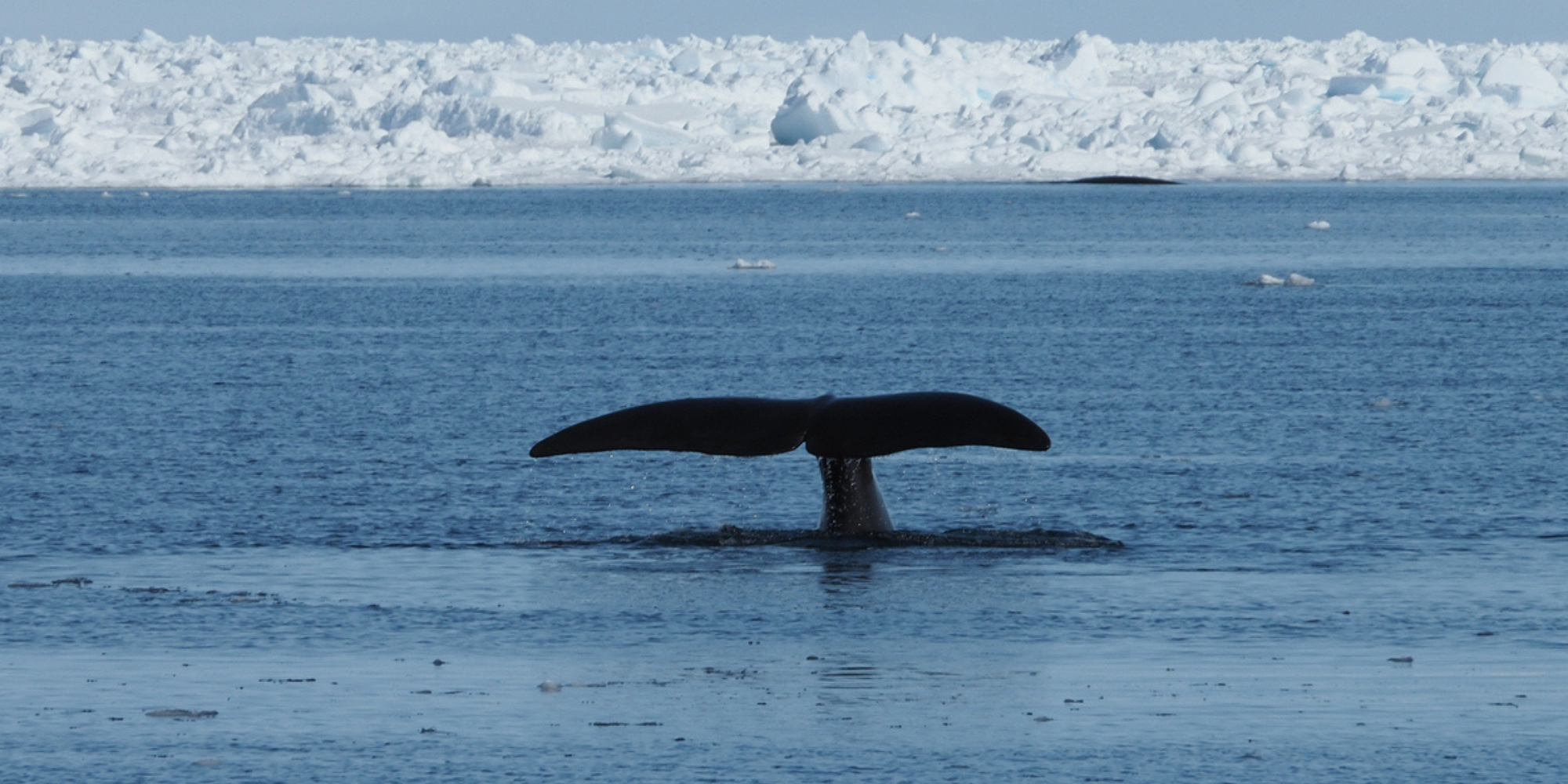Living exclusively in the Arctic region, the bowhead whale is the longest-living mammal on earth. It’s thought to live up to 200 years of age.
Situated in the harsh cold environment in northern Atlantic and Pacific waters, the bowhead whale is highly adapted to living in icy water. It is capable of breaking through sea ice up to eight inches thick, with its powerful body and big skull.
Bowhead whales keep warm with thick blubber layers, measuring up to half a metre thick. Entirely black except for the white front part of their lower jaw, bowhead whales can stay under water for up to an hour at a time, which allows them to swim under large ice floes.
Unlike most cetaceans, they don’t have a dorsal fin (it would awkwardly get in the way when swimming under ice!) They have extremely large heads, very stocky bodies and grow up to 18 metres long.
Bowhead whales are often spotted with scars on their bodies from them breaking ice, entanglement in fishing gear, and encounters with orcas. Scientists use these scars to identify and track individual whales.
Bowhead whales were initially thought to live around 100 years, based on the dating of stone harpoon tips recovered from the blubber of individual whales. However, newer research techniques suggest that they may live to be over 200 years old.
Scientists think the reason for the bowhead whale’s longevity, along with its slow growth rate and older age for reproduction, stems from living in the harsh Arctic environment.
Bowhead whales were hunted commercially in the early 1800s until the early 1900s. They were sought after because of the value of their oil and baleen – the fact that they are slow swimmers also made them an attractive target for whalers.
Like other whales, sound is vital for the survival of bowhead whales. They’re also highly vocal, possessing a wide variety of calls and sounds. Bowhead whales get their name from their very unique upper jaw and mouth which is shaped like an archer’s blow.
Where do bowhead whales live?
The species only lives in the polar Arctic waters of the northern hemisphere, and can mostly be found in shallow coastal water less than 200 metres deep, in amongst the sea ice. The whale moves further north in the Arctic region during the summer months as the sea ice melts.
Bowhead whales are usually found in regions including Canada, the U.S. (Alaska), Russia, Denmark (Greenland), Iceland and Norway.
Population
Whaling severely reduced the number of bowhead whales – from around 50,000 to 3,000 (estimated population in the 1920s). The population has recovered, somewhat, and is now thought to number 25,000 globally.
It is considered to be of ‘Least Concern’ on the IUCN Red List of Threatened Species. The East Greenland-Svalbard-Barents Sea and Okhotsk Sea subpopulations, however, are classified as endangered.

What do they eat?
Bowhead whales are baleen whales, so they feed by opening their mouths wide and straining food from water through their baleen plates. Bowheads have the largest baleen plates of all whales (up to 5-6 metres long).
They eat copepods (a group of small crustaceans), krill and other zooplankton though there is evidence that they also eat some small fish species.
Threats to bowhead whales
Entanglement in fishing gear
Like other cetaceans, bowhead whales can become entangled in fishing gear which goes on to cause injury, fatigue, comprised feeding and sometimes even death. Around 12 per cent of the Western Arctic bowhead whale population show scars from entanglement in fishing gear, mostly from commercial pot-fishing gear.
Hunting
Sadly, the bowhead whale is one of the few whale species still subject to an ongoing aboriginal subsistence hunt in Russia, the U.S. (Alaska) and Greenland, managed by the International Whaling Commission.
Vessel strikes
Bowhead whales are at risk of vessel strikes and this is thought to be of increasing risk, as sea ice melts due to climate change and vessel traffic increases in Arctic waters.
Environmental change and pollution
Climate change and pollution are a threat to all whales and dolphins because of the loss of habitat as waters become warmer.
As their life cycle and habitat is so closely connected to life in the Arctic circle, bowhead whales are a species more affected globally by climate change and the melting of the polar caps. The effects include reduction in food sources and changes in migration patterns.
Plastics and micro plastics, along with chemical pollutants, entering into the water system are a serious threat to all creatures in our ocean.
With their great blubber stores, research shows that bowhead whales tend to accumulate more chemical contaminants in their bodies which affect their long-term health.
Bowhead whales, like other cetaceans, use noise to communicate and to locate prey. Increased noise pollution from vessels and other human activity interferes with this ability.
Natural predators
Orcas have been known to prey on bowhead whales. In a study, scars consistent with orca attacks were found on approximately eight per cent of subsistence hunted whales.



